How to Block the Google Play Store in 3 Steps (Updated in 2025)
I was surprised that while the Google Play Store app allows parents to set age rating limits for downloads, it doesn’t give the option to block the app and prevent kids from downloading what they want. Even if it had a way to block the Play Store, my kids showed me they could easily adjust the settings and download any app they wanted.
The best method I found was to use a premium parental control app with comprehensive app monitoring features. Specifically, the ability to block any app, including the Play Store, from opening. After testing dozens of free and paid apps, I found that Qustodio was the best. I could block the Play Store completely or make it available for a limited time each day, and even more importantly, my kids couldn’t find a way to bypass the app blocker. Qustodio has a 30-day free trial with no credit card required, so you can try it for yourself, and enjoy all of its premium parental control features with no long term commitment.
Try Qustodio Free for 30 Days!
Quick Guide: Block the Play Store in 3 Easy Steps
- Get a premium parental control app: Qustodio is the best option. It has an excellent app management tool that has the capability to block any app, including the Play Store. You can try it for free for 30 days!
- Install it on your child’s Android phone or tablet: After purchasing a subscription plan, install the app on your child’s device and connect it to the parent account.
- Block access to the Play Store: Open the Apps and Games feature, and block the Play Store app or any other app that’s installed on the device.
How a Good Parental Control App can Help you Block the Play Store
Yes, the Play Store has integrated parental control options, but they’re very weak and easy to get around. The reason is simple; Google wants kids to download the apps from the Play Store. However, a good parental control app is focused on assisting parents in monitoring their kid’s online activities. It has teams dedicated to understanding what kids are doing online and developing tools to add parental controls that are compatible with Android phones and tablets. They study the latest tricks and hacks employed by kids and continuously update their apps to patch the vulnerabilities.
This is one of the main reasons why free parental control apps are never a good option for blocking apps. They don’t invest in upgrading and maintaining their app because they’re giving it away for free. I’ve found in my testing that my kids had an easy time disabling or simply bypassing the rules I set with free apps.
Among all the apps that I tested, Qustodio performed the best when it came to completely blocking the Play Store and other inappropriate content. The Apps and Games feature gives me control over every app on the device, so I can set unbreakable time limits for the app or block it completely.
When my child tries opening the Play Store after I block it, a Qustodio page covers the entire screen and tells them the app is blocked. Additionally, not only does Qustodio let me block the Play Store on the kids’ phones and tablets, but I can also use the web filter to block the website. This is important because if the child can access their Play Store account, even from a different device, they can still download apps to the phone or tablet.
My kids have not found a way past this lock screen. You can test it on your kids’ devices as well, by taking advantage of Qustodio free trial, which gives you 30 days to use all the premium features. Block your child from opening the Play Store app and website, and see how well it works for yourself.
The Best Apps to Block the Google Play Store on Android and PC in 2025
1. Qustodio: Powerful App Management Tools and Web Filter Completely Block the Play Store
- Block the Play Store remotely with one click
- Web filter has the option to block specific websites, including the Play Store
- Limit the amount of time the Play Store is accessible
- No proven way to bypass the restrictions and access the app
- Try it free for 30 days – no credit card required
When it comes to blocking my kids from accessing the Play Store, Qustodio was better and easier than any other app I tested. After installing the app on my child’s Android phone, I opened the dashboard and clicked on the Apps and Games features; then, I could just block the app. I immediately tried to open the Play Store on my child’s phone and was happy to see that the app blocker was enabled almost instantly.
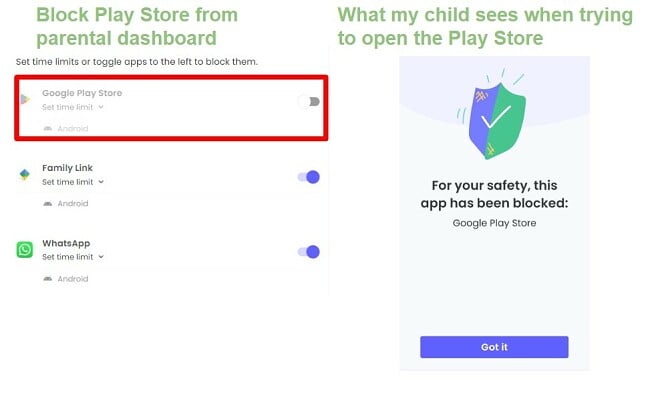
You can also use Qustodio to add time limits to the Play Store. Since I know that there are times when my child needs to download an app, I’ll adjust the settings and set a 15 minute screen time limit for the play store app. I can choose if I want that setting to be applied on a specific day or as a daily occurrence. Once the app is downloaded, I can always block the app again.
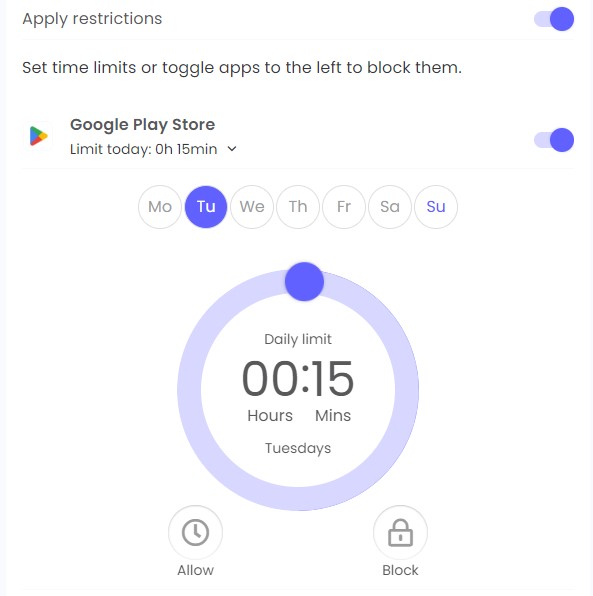
The web filter is the final tool available through Qustodio for blocking the Play Store. It has a customization option that allows adding URLs to a blocklist. I found that if only blocked the app, the kids could just access the Play Store from their browser. This option prevents that sneaky bypass. Another advantage of this feature is that a Qustodio account can be installed on multiple devices, including computers. If I don’t block the Play Store website, my son can go to his computer, log into his Play Store account, and remotely download apps to his phone.
The only way to get around the Qustodio Play Store block is if my child logs into his Play Store account from a friend’s device and remotely downloads and installs the app. However, if this should happen, I’ll see that he has a new app on the Activity Timeline, which has a detailed breakdown of what actions took place on the phone, and then I can simply block the new app, just like I blocked the Play Store.
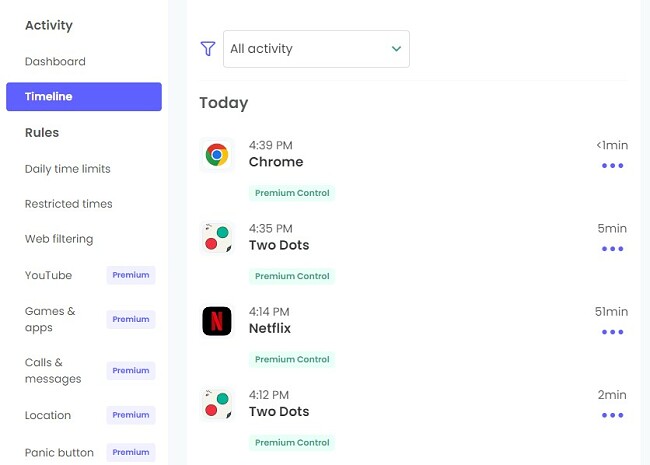
Qustodio does a lot more than just block apps like the Play Store. It has multiple screen time features, so I can create a detailed usage schedule of when I allow my children to be on their devices and limit the amount of screen time they have per day. There is also an Instant Lock, which lets me remotely lock the device from anywhere at any time.
In addition to blocking specific URLs, the customizable web filter has 29 categories. I can choose the sensitivity level for each category, and it sends me alerts anytime my child attempts to access websites that trigger a blocked category.
I set the rules and view detailed reports in the parental dashboard, which is accessible through the Qustodio parent app or a web browser. It makes it very easy to monitor my children and make any app access or screen time rule adjustments remotely without needing to get on their phones, tablets, or computers.
Qustodio offers a 30-day free trial, with access to the premium features, such as blocking or setting time limits of apps like the Play Store, with no credit card required. Register your account, install the app on your child’s device, and see for yourself how easy it is to block the Play Store.
2. Bark: Block the Play Store App With the Screen Time Routines
- Customize which apps can be used or blocked
- Real time alerts for all newly installed apps
- Remotely pause the internet at any time
- Try it free for 7 days!
I usually think of Bark as more of a monitoring app than an app that places restrictions on the device, so I was very interested to see how it handled blocking the Play Store. After installing the app, I looked through the dashboard for the app blocking features and couldn’t find them. As I thought, it only has the option to block social media, email, and messaging apps it monitors.
However, after a few more minutes of searching, I found an excellent way to use Bark and block the Play Store. The screen time feature is fully customizable, so I can choose which apps and app categories to allow or block at different times throughout the day. I opened the rules and saw that it gives me the option to block App Stores and System Updates.
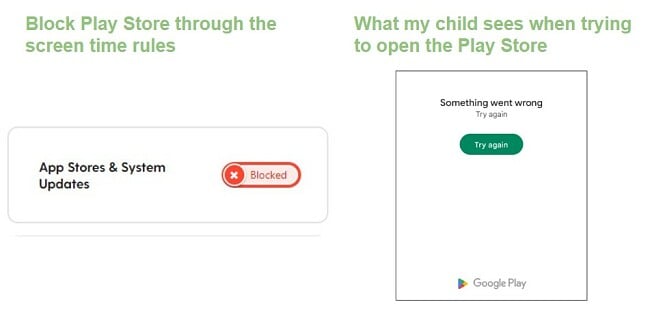
I added this rule to all four of the available screen time segments, School, Free Time, Default, and Bedtime, to block the Play Store at all times. What I like about this method is that if I want to allow some time when my child is at home for access to the Play Store, I can design the schedule to unblock the Play Store for a specific date and time.
Bark also has the option to block any URL, so I can block the Play Store website from the phone’s browser. This is also done through the screen time rules, so I had to ensure the block was added to all the time segments.
The Insight section of the dashboard has two helpful features that allow me to see if my child is trying to get past the blocker or installing apps without going through the Play Store.
- Newly installed app: Bark compiles a list of any newly installed or updated apps, including the date of the installation. This is helpful in letting me know if my child is accessing the Play Store through a different device or computer or downloading the app files through third-party websites and installing them on the phone.
- Alerts: If my child attempts to open the Play Store app or website while it’s blocked, it will register an alert.
![Bark alert]()
Bark has two plans, Bark Jr. and Bark Premium. If your only concern is blocking the Play Store, or other apps, then Bark Jr. has the features you need. However, you will need Bark Premium if you also want to monitor over 30 social media and email accounts, including Whatsapp, Instagram, Snapchat, Gmail, and more. If you’re unsure, take advantage of the free 7 day trial for access to all the premium features, and see which option is best for your needs.
3. Norton Family: Blocks Play Store App and Website from Remote Dashboard
- Create custom rules and block any app and website
- Use the School Time feature to block Play Store at specific times
- View all app activity from the parental dashboard
- 30-day free trial
The Norton Family parental control app has improved a lot since I first started testing it. After installing Norton Family, I went to the App management tool, which lists all the installed apps on the phone, and blocked the Play Store app.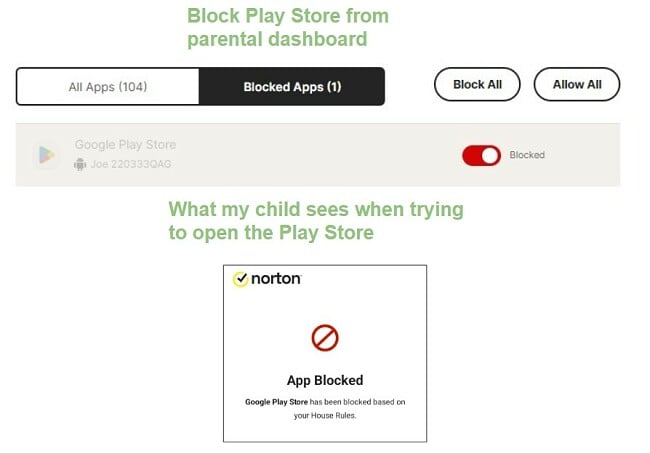
As soon as I made the change on the dashboard, I saw that a notification popped out on the child’s phone with an update to the House Rules. This is a feature that Norton Family puts on the child’s device, so they know what they can or can’t do on the device and if there are screen time limits, location tracking, and more.
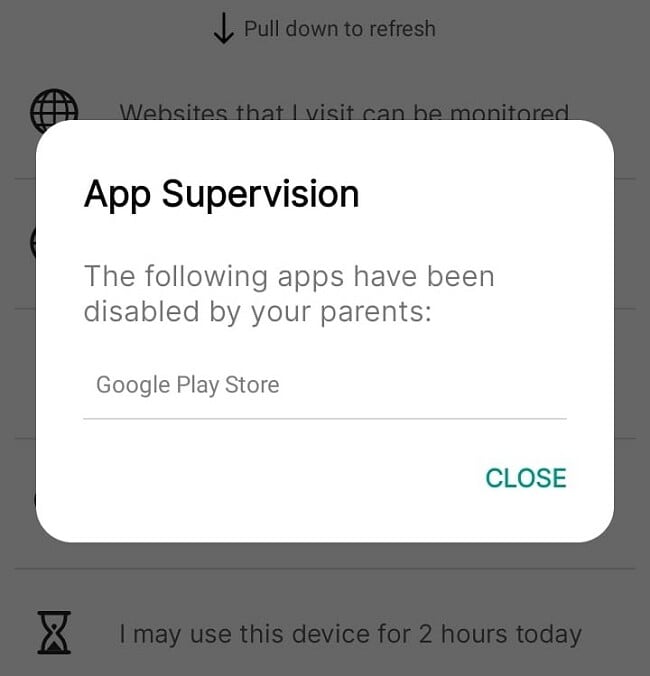
After seeing the phone received the updated rules, I asked my son to open the Play Store to see if it worked. I was surprised to see that it opened and let him download an app with no trouble. I waited another 20 minutes and tried again, and this time the app was blocked. Throughout the next few days, I had him try and open the app another 10 times, and twice it let him on. I couldn’t find a pattern or a reason why the app blocker wasn’t working every time. While the app blocking feature didn’t block the Play Store 100% of the time, I did receive an alert, with a time stamp, whenever an app was installed or uninstalled from the device.

The secondary method for blocking the Play Store is through the web filter. I blocked the URL, making it impossible to log in and download apps from the Play Store website. Unlike the app blocker, this feature worked 100% of the time.
If you don’t need to have a constant block on the Play Store app and website, the Norton Family School Time feature makes it easy to create rules of what apps and websites are available throughout the day. The feature’s main purpose is to block distracting apps and games when a child is in school or doing homework, but as long as you add the Play Store app and website to the restricted list, it will block them when the School Time feature is active.
Norton Family has a 30-day free trial that gives you unlimited access to all premium features, so you’ll have enough time to test the app and see if this is the right parental control app for you.
Can I Use a Free Parental Control App to Block the Play Store?
I really wanted to find a free app that could block the Play Store. I downloaded and installed over a dozen free apps, and none of them were any good.
The most common problem was that the app didn’t work. This is typical with free apps. Parental control apps require frequent updates in order to keep up with the latest search terms, trends, and methods for bypassing the rules A company that is giving the app away isn’t investing in continually developing the apps because they aren’t profiting from the it.
The few that did initially work proved no match for my kids, who quickly found a way, usually with a VPN, to bypass the rules. Another quick trick they used was opening a browser and going to the Play Store website.
As a user, I generally steer clear of free apps that gather data from my children’s phones because I’m aware that these companies need to generate revenue somehow. Regrettably, they often do so by selling user data to marketing firms, which then use it to tailor advertisements based on their online behaviors.
This is why I prefer to pay for apps that should protect my kids online. Their safety, and my peace of mind, is well worth the little inexpensive costs of these apps. If you’re still unsure, you can take advantage of the Qustodio free 30 day trial, with no credit card required, and see for yourself how it performs. You’ll be able to block the Play Store, and have unlimited access to all the other premium features, such as screen time tools, a powerful web filter, and 24/7 location tracking.
What About Google Family Link
When it comes to free parental control apps, Google Family Link is the biggest disappointment. When kids turn 13 they receive an email from Google giving them the option to opt out of the Supervision mode. This means that I can’t block apps, set time limits, or view their online activities.
However, even if I insist that my kids keep Supervision mode active, Family Link doesn’t have the option to block the Play Store, despite the fact that it allows me to block every other app on the phone. As I looked through the list of apps, I saw that it did have Play Games and Play Music services, but there is no option for blocking the Play Store.
The only possible explanation I could think of is that Family Link relies on the integrated parental controls that I can activate on my child’s Play Store account. However, these rules don’t block the app, all it does is let parents restrict apps based on the app’s age ratings.
FAQ
What’s the best way to block the Play Store on Android?
Can I use a free app to block the Play Store?
Can kids open the Play Store app even if it’s blocked?
Only a Premium Parental Control App Can Block the Play Store
To protect your kids from online risks, it’s vital to set clear limits and restrict certain apps, like the Play Store. It’s just as important to use the right tools designed for this specific purpose. Don’t rely on an app just because it’s free because you’ll get what you pay for and your child will be able to disable the free app in no time.
I found 3 premium parental controls that had the tools to block the Play Store with no easy workaround. Of the 3, Qustodio is my top choice. It lets me block the Play Store completely or create a schedule for when the app is available. It also lists all newly installed apps, so I can see if my child installed an app remotely or by downloading an APK file. You can start using Qustodio free for 30 days, no credit card required, and see for yourself how the powerful app blocking features work for your family.

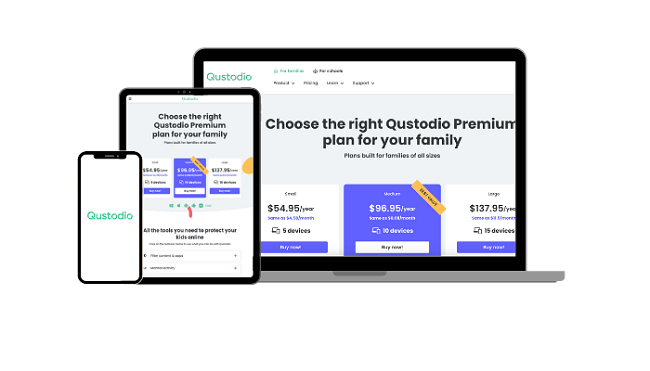
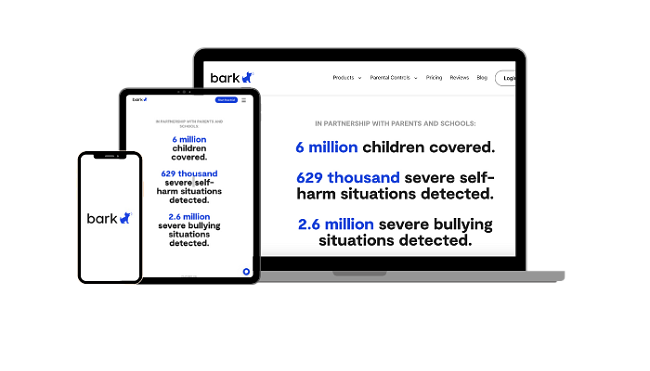
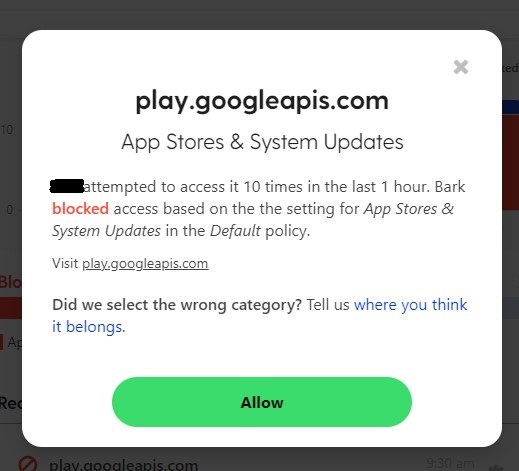
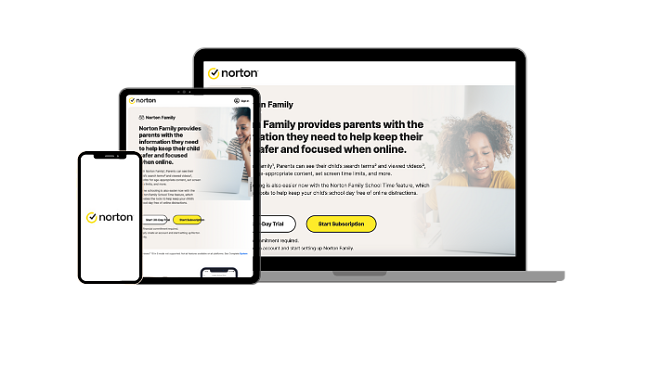

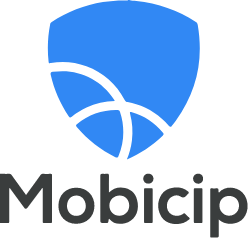


Leave a Comment
Cancel